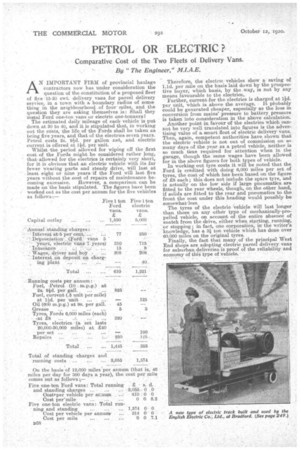PETROL OR ELECTRIC?
Page 50

If you've noticed an error in this article please click here to report it so we can fix it.
Comparative Cost of the Two Fleets of Delivery Vans. By. "The Engineer," MIA.E.
AN IMPORTANT FIRM of provincial haulage contractors now has under consideration the question of the constitution of a proposed fleet of five -15-20 cwt. delivery vans for parcel delivery service, in a town with a boundary radius of seinething in the neighbourhood of four miles, and the question they are asking themselves is: Shall they instal Ford one-ton vans or electric one-tanners?
• The estimated daily 'mileage of each vehicle is put down at 30 to 40, and it is stipulated that, in working. out the costs, the life of the Fords shall be taken as being five years, and that of the electrics seven years. Petrol costa 2s. 90. per gallon net, and electric current is offered at lid. pe.r Unit.
Whilst-the period allowed for wiping off the first cost of the Fords might he considered rather long, that allowedfor the. electrics is certainly very short, for it is obvious that an electric vehicle with its far fewer wearing parts and steady drive, will last at least eight or nine years 'if the Ford will last five years without the cost of repairs of maintenance becoming excessive. However, a comparison. can be made on 'the. basis stipulated. The figures have been worked out as the cost per annum for the five vehicles as follows:— Therefore, the electric vehicles show a saving of 1.1d. per mile on the basis laid clowri by the prospective buyer; which basis, by the .way, is not by any means favourable to the electric's., Further, current for the electrics is charged at 10. per unit, which is above the average. It pi-obably could be generated cheaper, especially as the los& in conversion from mains' pressure to battery pressure is taken into consideration in the above. calculation.
Another point in favour of the electrics which can
not be very well translated into figures is the advertising value of a Kin art fleet of electric delivery vans. Then, again, competent authorities have shown that the. electric vehicle is not out of commission on so many days of the year as a petrol vehicle, neither is so much time required for attention when in the garage, though the same wages have been allokved for in the above figures for both types of vehicle.
In working out tyre costs it will be noted that the Ford is credited with doing 6,000 miles per set of tyres, the cost of which has been based on the figure of 28 each ; this does not include the spare tyre, and is actually .on the low side if large pneumatics are fitted to the rear wheels, though, on the other hand, if solids are fitted to the rear and pneumatics to the front the cast under this heading would possibly be sornewhat.less.
The tyres of the electric vehicle will last longer than those on. any other type of mechanically-propelled vehicle, on account of the entire absence of snatch from the drive, either when starting,.running, or stopping ; in fact, one corporation, in the writer's knowledge, has a ai ton vehicle whick has done over 60,000 milcs on the original tyres.
Finally, the fact that many of the principal West End Shops are adopting electric parcel delivery vans for suburban deliveries is proof of the reliability and economy of this type of vehicle.




























































